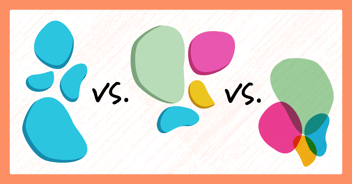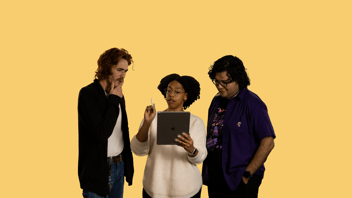
Any successful business manager will tell you that teamwork is key.
While I could list off a few "inspirational" quotes praising the power of teamwork (Teamwork makes the dream work, perhaps?), let's avoid such vague cliches and just get right to it.
Teamwork is best defined as the combined action of two or more people that effectively leads to the desired outcome. It requires those people to be operating on a similar "wavelength"—and to understand the goal and each other.
However, not everyone is the same, not everyone's brains and bodies work in the same way. Therefore, trite metaphors about gears operating together or a battalion of soldiers marching in step just don't reflect reality.
But rather than being an obstacle, we believe all this presents an opportunity: an opportunity for success as a direct result of the presence of diverse people, not in spite of it.
Before we get into that, though, let's take a look at some examples of the hidden ways in which people differ.
Hidden Illnesses and Neurodiversity
When we think of an "ill person", we almost always think of someone who exhibits clear, outward signs that they're ill: they're in a wheelchair, they're regularly short of breath, or maybe they carry around a blood glucose monitor.
Think of someone with restless leg syndrome—how do you think they would manage a two hour meeting. They might appear antsy, uncomfortable, or disengaged—this interpretation might cause people to question their contributions and value.
There are so many illnesses, however, some remain hidden from visual inspection. They are invisible or hidden disabilities, or neurodiverse people.
A person with Asperger's syndrome, for instance, may seem to function "normally" to their work colleagues, leading to confusion should that person miss out on a social cue and so misinterpret a task assignment. Instead of understanding what's happening, they may hold this against that employee, either consciously or unconsciously.
Someone with bipolar disorder may go above and beyond in completing their tasks one month, bringing charismatic enthusiasm and morale to the workplace, only to seem like a completely different person the following month, one who has an incredibly tough time contributing.
These people are neurodiverse, simply put, their brains operate differently.
Therefore, they require some special understanding from their more neurotypical bosses and work colleagues—despite the message society gives off, mental health is just as valid as physical health.
When allowed to thrive, neurodiverse people can bring incredible benefits to the workplace.
The Benefits of Having a Neurodiverse Workplace
Effective teamwork requires one thing more than any other, empathy.
When an employee puts themselves in another's shoes, they can gain a better understanding of their experience and perspectives. When people understand each other, they work better together.
Additionally, neurodiverse people can bring unique talents to the job.
Did you know that workers with autism, for instance, actually tend to get more done than neurotypical colleagues? Employees with disabilities also tend to be less likely to leave the job, and other workers become inspired by their triumphs in spite of daily difficulty.
If you ignore neurodiverse applicants, you're ignoring a talent pool of more than 10 million Americans and their unique outlook on things.
Consider someone with dyslexia—they may not always intuitively understand a page of writing the same as their colleagues—it might take extra care to make a user interface on an app supremely comprehensible and so improve its quality and raise ROI.
Someone with chronic anxiety may come up with ideas for marketing a product to people's emotional needs, while someone with ADHD may determine how to make an advertisement more succinct.
We use the term neurodiverse to refer to people who are different, but not at all as a detraction from their abilities—there are many, many neurodiverse people out there, and neurodiverse workers can help your company reach them.
The empathy of your workplace translates into empathy towards society at large, boosting both positive brand perception, and ultimately, profit margins.
One recent report from Accenture showed that hiring employees with disabilities actually improves profit margins, in spite of the idea that it'll cost too much money to train them.
Not to mention, there are tax incentives and grants for doing so.
All-in-all, having robust diversity and inclusion programs are only positive as they increase team cohesion, morale, and happiness—and thereby productivity—and actually make companies more profitable.
Being more conscientious of peoples' disabilities
So how can you successfully integrate people with hidden disabilities into the workplace.
The first thing, as mentioned above, is to be more empathetic. People may not disclose their disabilities, so, don't assume that everyone is working the same way, and don't become impatient if something must be explained multiple times.
And if someone says they need time off of work due to a hidden disability, don't just think they're making it up—do your best to work with them.
By understanding that neurodiverse people and people with hidden disabilities are a significant portion of the population, you can be more informed because at any moment you might be working with a neurodiverse person, or someone with a hidden disability.
If you do know one or more of your employees experiences a hidden disability, take some time to research—even cursory research of how they interpret the world or may have difficulty with certain things can help you be more understanding and helpful.
Seneca Hue can help
If you couldn't already tell, at Softway we are passionate about workplace integration, for everyone. Our brand new D&I platform, Seneca HueTM, is designed to facilitate just that.
If there's anything that makes us more interconnected, both literally and figuratively, it's technology. Seneca HueTM takes advantage of that fact to bridge any gaps between diverse workers in a fun, easy-to-understand way.
Think of it as the Sesame Street of D&I. With Seneca Hue, you'll learn how to understand one another, improve teamwork, and reap the many benefits of diversity and inclusion in your organization.
The time for understanding and constructive conversation is now, and it can start today—schedule your demo of Seneca Hue and bring the power of diversity and inclusion to your organization.




